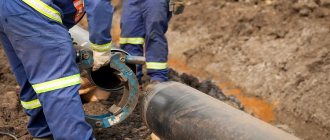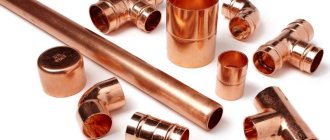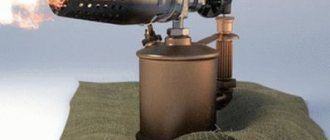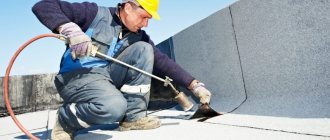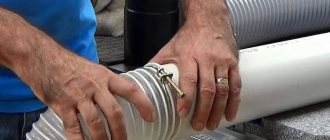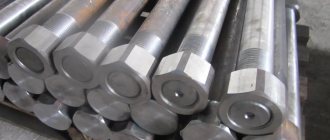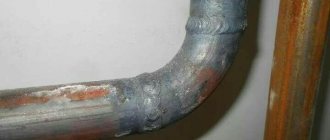Today, there are many options for connecting pipes in pipeline structures. The choice of connection depends on various factors, but the material from which the communication elements are made plays a major role. The second important factor is the type of work environment. It is also worth noting that the operating conditions of the pipeline play a big role.
The connection method is selected depending on the type of pipes, their diameter and the purpose of the future pipeline
Types of connections
All existing pipe connections are divided into two main groups:
- detachable;
- one-piece.
The use of detachable connections allows, if necessary, to disassemble the joint section. Thanks to this property, it is possible to repair and replace the joint without compromising the integrity of the pipes. Detachable joints include threaded connectors (fittings) and flanges.
In the case of permanent joints, it is possible to disassemble the pipeline, however, this will lead to damage to the pipe material. The most popular option for permanently connecting pipelines is welding. In addition, there are a number of other methods: gluing, pressing, installing a socket using cement mortar.
All of the above methods are quite popular and are used to connect pipelines transporting various media: water pipelines, heating communications, gas networks, sewer systems, as well as industrial and technical lines.
Welded joints
Welding is a very popular method of joining individual parts in a pipeline structure. This method is especially in demand when installing technical communications in factories.
The most commonly used method for installing steel pipelines is hot welding.
It is worth noting that not only individual parts in metal structures, but also plastic products can be connected by welding. In some cases, welding is also used to join glass parts.
Depending on the method of exposure to the material, there are two main methods of such connection:
- fusion welding;
- pressure welding.
Fusion welding has many implementation options:
- electric arc;
- simple electric;
- electrobeam;
- laser;
- gas welding.
The most popular among these options is the first one. The use of electric arc welding implies that the heating source is an electric arc. This type of work can be performed in two ways:
- with alternating current;
- with direct current.
Helpful information! Butt welding of the connected pipeline elements allows the work to be carried out at lower financial costs. This is due to the fact that welding equipment is less expensive and also requires less energy consumption during installation.
Metal welding can be done with electric or gas equipment
This type of installation can be carried out using various equipment, so three types of welding can be distinguished:
- manual;
- semi-automatic;
- automatic.
Types of welded joints
There are different methods for welding individual parts in pipeline communications. Let's look at them:
- end-to-end;
- overlap;
- corner;
- with welding of various elements.
The most popular and common are the following welding connections:
- Butt (longitudinal and transverse). With this welding option, backing elements - rings - can be used. The seam in such joints can be one- or two-sided. The latter is used in cases where the part has a large cross-section - more than 500 mm.
- Angular (one-sided and two-sided). This option can be done in different ways. In some cases, corner joints are welded with an edge bevel, and in others - without it.
- Socket-welded overlap clutch. The socket connection is used to join pipeline elements with a high ductility coefficient. These include parts made of non-ferrous metals, as well as plastic elements.
In addition, square pipes, which are used in construction and the production of various furniture, are also connected by welding. They are not suitable for installation of pipelines. This is due to the shape of their cross-section - it worsens the flow characteristics, while round is the best option for pipeline structures.
Butt welding is used for pipes whose diameter exceeds 50 mm
Connection of dissimilar pipes
Often, when installing new or reconstructing old communications, it is necessary to connect sections of pipes made of different materials. For example, metal with plastic or metal-plastic with steel. In such cases, choose one of the methods using special fittings.
- Adapter coupling.
The coupling for connecting metal and plastic pipes has a plastic body and a steel insert with a union nut. A metal pipe is inserted into the threaded part, and a plastic pipe is soldered into the body.
Metal-plastic coupling Source fwater.ru
- Compression double-sided fittings.
One part of such a fitting is put on a plastic pipe and secured to it with a collet connection. This is usually a crimp coupling. The second part is threaded or flanged. To connect a flexible watering hose, the fitting is equipped with a herringbone adapter.
Crimp coupling with flange Source prom.st
- Flange adapter.
Consists of a coupling, flange and adapter, secured with studs or bolts with nuts. When tightening the fasteners, the clamping rings secure the ends of the pipes, forming a strong connection.
Connection using a flange adapter Source ooosoyuz.ru
Note! It is better to trust the joining of pipes of heterogeneous materials to specialists who will select the most suitable method and carry out installation in accordance with all the rules.
Threaded connections
But what to do in cases where it is not possible to carry out welding work? There are quite a few ways to join pipeline elements without welding. The most popular option is threaded installation. Pipe threading is done using cutting machines or an ordinary die. If it is necessary to apply threads to a product with thin walls, use the rolling method.
If you follow all the rules for installing a threaded joint, you will get a durable and sealed structure. Let's consider the main advantages of using such a connection:
- ease of installation.
- the ability to repair or replace without damaging the pipeline;
- installation is carried out without the use of special equipment.
In addition, there are several thread parameters that determine its operation:
- cutting step;
- depth;
- direction.
The pitch determines the distance between the top of the coil and its base. Depth is a parameter that is determined as follows: the distance between the base of the coil and its top is measured. The direction of the thread is an important point; if you ignore it, you may encounter problems when installing the pipeline structure. The thread has two directions:
- right;
- left.
Many types of pipes are equipped with threads; they are used where it is necessary to create a reliable but detachable connection
Flange types
Before talking about welding flanges, it is important to study their design features. Dimensions and shape are regulated by GOST or technical specifications. They vary in geometry, size, and are made from high-carbon or alloy stainless steels or forgeable cast iron.
Based on functionality, there are two groups of flanges:
- reinforcement;
- intended for vessels and apparatus.
Structurally, flanges are divided into several types:
- Collar type - used on high pressure systems. The neck tapers along a cone; it is made in the form of a conical centralizer that distributes the flow pressure. According to the American classification, it is called “Lap Joint” (lap welded). Attached with a continuous bead or V-shaped seam.
- Socket-shaped - used on technological lines of small cross-section, designed for high pressure of the transported medium, marked “Socket-welding” (with a cavity for the seam). It is welded only from the outside; it is necessary to leave a gap of up to 1.6 mm in case the pipe expands when heated with a hot medium. The corner seam is made end-to-end.
- Slip-on or through - attached at a distance of 3 mm from the edge of the pipe, international designation “Slip-on” (with a through hole). Fixed on both sides with a fillet weld - welding to the outer and inner walls.
- Blind - performs the function of a plug, forms a collapsible connection with the pipe, and may have the inscription “Blind flanges”. It is not attached by welding, it is held on by a bolted connection.
- Flat - consists of a ring and a plate, designed for low pressure up to 2.5 MPa, only the ring is attached to the outer edge of the pipe by welding, the plate remains movable.
- Threaded - used on embedded fittings where there is threading or rolling, marked “Threaded flanges”. It is attached to the end of the pipe mechanically, rarely additionally fixed by welding.
Other types of pipe joining without welding
The use of threaded connections is the most popular and widespread method of installing pipeline structures without welding. However, there are other types of pipe connections that are worth paying attention to.
The choice of method, as a rule, depends on the material from which the pipeline is made. All pipes can be divided into two types:
- flexible;
- hard.
The first group includes products that consist of various polymer materials: polypropylene (PP), polyethylene (PE), as well as metal-plastic products. The second group does not have such ductility and includes: steel, cast iron, polyvinyl chloride (PVC), copper, etc.
Important! When installing flexible pipelines, greater coverage of the pipe material is required to ensure a reliable connection than when implementing joints in rigid pipelines.
How to calculate the seam size?
First, remember that the size of the seam depends on the pipe itself. Welding flanges to steel pipelines in this case will be regulated by the width of the internal seam.
Secondly, as a rule, it is equated to the thickness of the wall, with a height ranging from 0.5 to 1 cm. The external seam, according to welding rules, must exceed the internal seam in thickness.
Now that we have decided on the type of flange you have, we can get to work. Here again the question arises.
Connecting flexible pipes without welding
Often, in order to install a pipeline without the use of welding equipment, special connecting elements - fittings - are used. Fittings for flexible pipes must have a large reach to make a reliable and airtight joint.
Compression fittings allow you to create a tight connection without welding or threading
As a rule, fittings are used in flexible pipelines that have small or medium cross-sections (from 20 to 315 mm). For parts with a diameter above 315 mm, a fitting joint is not practical. This is due to the fact that the reliability of such a connection is quite low.
For joining low-pressure polyethylene (HDPE) products, special compression fittings are mainly used. The joining of individual elements in a pipeline structure using compression products allows for quick installation, which is also inexpensive and simple.
However, compression products are most often used to connect small diameter pipes. Medium-diameter pipes are connected using couplings. The coupling is perhaps the most common fitting option.
Welding the flange to the pipe
Before welding work, edge preparation is carried out. The seams are cleaned until shiny. When independently assembling metering units or inserting shut-off valves, it is important to take into account the thickness of the sealing gasket; the disc is installed taking into account the thickness of the rubber. The bolt heads on the flanges are located on one side only. The ends protrude at least 3 threads. The disk mirror is always located above the seam and edge; the edge of the rolled product should not extend beyond the plane of the disk. Tack joints help to weld the flange to the pipe evenly; when the disk is immobilized, you can start making seams.
At a pressure of up to 10 MPa, welding is carried out without a bevel; at a high pressure, up to 25 MPa, welding is carried out with bevels.
Rotators are used to weld flanges to steel pipelines. They give the unit mobility, improve access to the working area, and facilitate the welding process. During the welding process, the electrode remains stationary, the assembly gradually rotates around its axis. The rotator is used to finish cleaning the seams, priming and painting the flange assembly.
Important points when assembling a flange connection:
- it is necessary to fasten the disk perpendicular to the pipeline, a control triangle and a probe are used for checking, the permissible deviation is 2% of the outer diameter;
- the axes of the bolt holes on the two disks must coincide; alignment is checked with a level and plumb line. Permissible deviations: a) 1 mm for holes with a diameter of 18 to 25 mm; b) 2 mm for diameters up to 41 mm.
The permissible disc deviation is 2% of the outer diameter.
The “boat” technique is used for connections without backlash; the edges are welded to a greater depth. If the gap is within 1.5 mm, welding is performed with transverse oscillatory movements, the electrode is held at an angle of 30° to the surface of the pipe. A backlash of 4–5 mm is formed using a fillet seam with large stitches (cathetes). If the gap is large, two penetrations are allowed.
Connecting rigid pipes without welding
As mentioned above, inelastic pipes are often joined using threads. But there are methods that allow you to connect individual elements of rigid pipelines without the use of welding and threading. Docking without welding equipment is permitted on parts with a diameter of up to 600 mm.
If it is not possible to cut a thread on a rigid pipe or use welding for joining, then the pipeline is mounted using couplings
In order to install a rigid structure without the use of welding equipment, couplings are usually used. The coupling joint allows you to connect the following pipe options:
- equal in diameter;
- with different diameters;
- from various materials.
The connection obtained using such a fitting is characterized by high strength characteristics and good tightness. If it is necessary to connect two pipes without welding and threading, as a rule, special devices are used - flanges. They are also widely used for connecting various equipment to pipes.
Flange connections are recommended for use in cases where a specific section of the pipeline requires frequent inspections or periodic repairs. This is due to the fact that such a clutch is easy to disassemble and reassemble. It includes:
- two connecting flange elements;
- sealing ring;
- nuts and bolts.
Detachable connections
Connections that can be disassembled without damaging the pipes and with the possibility of reassembling them include threaded, socket and quick-release.
Threaded
Connecting pipelines using threads is one of the most popular joining methods. For cutting threads, a special tool is used - a die; for single joints, you can use a regular die.
Set of dies for thread cutting Source maxmaster.ru
For reference! Threads are rolled onto thin-walled pipes, but doing this at home is problematic due to the need to use special machines.
Threaded connections are sealed and durable, they are easy to install, and allow you to quickly separate joints for dismantling or repairing communications.
The thread can be right or left, external or internal, and differs in pitch and cutting depth, which must be taken into account when connecting two sections.
Quick release (QRC)
Couplers are used on pipelines, the operation of which requires their periodic disassembly. For example, in irrigation systems or seasonal water supply to a country house. These types of pipeline connections are easy to install, allow installation quickly and without the use of tools, and have good tightness and strength.
Fittings-connectors for quick-release connections consist of two parts, each of which is installed on the ends of the pipes being connected.
- The coupling is a receiving part, in the body of which there is a built-in check valve, a rubber gasket-seal, and a fixing clamp.
- Nipple – mating part with connecting adapter.
Cam-type couplings Source prom.st
Couplers may differ in design, material from which they are made, internal diameter, wall thickness and other parameters. For household and household needs, products with a diameter of up to 50 mm are produced. Such fittings are available in different versions: for straight and angular connections, in the form of crosses, tees.
When choosing a connector, be sure to take into account not only the diameter, but also the type of pipes. If they are made of metal-plastic, polyethylene, polypropylene or other plastic and flexible polymer, a large girth along the length of the pipe is required for reliable articulation. Due to their lack of reliability, quick-release methods for connecting pipes are not recommended for hidden laying of pipelines - underground or in a screed.
Coupled and flanged
Medium and large diameter pipes up to 600 mm are often connected using couplings or flanges.
Coupling connection Source strojdvor.ru
Couplings can be used to connect not only identical pipes; they often serve as adapters for products of different diameters or made of different materials.
For hermetically sealed joining of rigid pipes, especially large cross-sections, as well as for insertion into the system of control or auxiliary equipment, flanges are used. They consist of:
- two connecting elements mounted on the ends of the pipes;
- o-ring;
- fasteners - bolts and nuts.
Flange connection Source kanaliza.ru
Flanges are easy to install and disassemble, allowing you to quickly break the connection of pipes without harm to them.
See also: Catalog of companies that specialize in engineering systems (heating, water supply, sewerage and others) and related work
Bell-shaped
Detachable connections of pipelines by joining into a socket are used when installing domestic non-pressure sewage systems. Sewage moves through sloped pipes by gravity; transfer pumps are not used in such systems, so the pressure in them is minimal. This makes it possible not to achieve high strength joints.
The inner diameter of the socket corresponds to the outer diameter of the pipe. To ensure a tight connection, a rubber sealing ring is installed in the socket.
Connecting sewer pipes into a socket Source santehnic-doma.ru
However, a detachable socket connection is used only for plastic sewer lines. Cast iron pipes joined in this way are additionally fixed with cement mortar or sealant. These materials, when hardened, make the joints permanent.
Non-standard methods of connecting pipes
In addition to the traditional methods of joining pipes, which are the most common, there are also some special installation methods. Pipes can also be made of non-standard material, which requires a special connection.
Sockets are most often used to connect sewer systems
Let's consider the following docking methods:
- gluing;
- bell joint;
- quick connectors.
The first option is used if the structure is made of plastic. The gluing method allows you to obtain a strong and hermetically sealed permanent connection. Joining pipes in this way is done by applying a special glue to them.
The socket connection is used, as a rule, when installing non-pressure sewer systems. In such systems, wastewater moves naturally at an angle, without the use of a special pump. Depending on what material such a pipeline is made of, there may be a detachable or permanent socket connection. The detachable version of the socket coupling is used when installing plastic communications, and the one-piece version is used when installing cast iron pipes. The socket is sealed in cast iron structures using a cement composition or special sealants.
Helpful information! Quick-release or quick-release connections are installed if the operational features of the communication require its frequent disassembly.
Let's look at the main options for quick-release connections:
- clamps equipped with a fixing wedge;
- cam (Camlok);
- ISO connection.
Flexible pipes and hoses can be connected using quick connect fittings such as Camlok
These clutch options are easy to install and have good strength characteristics.
It is also worth noting that for joining pipes that are used for industrial purposes, the following joints are used:
- nipple;
- telescopic;
- articulated.
The first option is used in cases where it is necessary to connect pipes with any measuring equipment, and the second - when joining rigid pipes equipped with flexible elements. The hinged type is used in the construction of highways with complex shapes. This connection allows you to compensate for the effect of twisting the pipeline.
Bonding parts of a plastic pipeline
PVC pipes are connected to a socket using the gluing method. For better adhesion, the socket inside and the tail of the inserted pipe are sanded to make the surface rough. Next, the chamfer is removed, and the treated parts are degreased using methylene chloride as a primer.
Before making a connection, check the pipes for compatibility. A pipe of smaller diameter should fit into the socket freely, but not too much. Then a line marks the boundary for applying glue - this will help to join the parts without errors.
On the surface of the elements being connected - 2 thirds of the socket recess, as well as the fully calibrated end of the pipe, glue is evenly applied in a thin layer. The pipe is inserted into the socket and turned a quarter turn to improve contact between the elements being connected. The joined parts are held until the glue sets.
Special aggressive adhesives are used for gluing polyvinyl chloride pipes. The process is similar to welding, but without high-temperature exposure; it is replaced by a chemical reaction, as a result of which the surfaces of the connected parts of the pipes are dissolved and transformed into one whole by copolymerization
The process takes only 20-30 seconds. If a uniform layer of glue appears at the joint, it is immediately removed using a piece of clean cloth. From gluing to complete stabilization of the connection and testing the pipeline for leaks, at least a day should pass.
Image gallery
Photo from
PVC pipes for bonding
Treating pipes before joining
Rules for applying glue to PVC parts
Joining glued parts
To repair existing pipelines, shaped parts are used in the form of repair couplings or products with an extended socket. A section of pipe is cut out, the ends are chamfered, and special glue is applied to the ends. The coupling is placed on the bottom of the pipeline.
A coupling with a long socket is placed on the top of the pipeline until it stops; if required, a shaped part is mounted on it. Move the coupling along with the shaped part down until it connects with the bottom of the pipeline. The sliding coupling is moved upward so that it covers the joint area.
A repair coupling differs from a regular coupling in that it does not have a side inside, so during the repair process the bell of any pipe can be moved through it
If even after this there is a leak, the joint is filled with silicone sealant. The bottom and top are determined depending on the direction of movement of the transported substance.
Features of connecting profile pipes
Profile pipes have good strength and relatively low weight, so they are often used for the installation of frame structures, as well as for other construction purposes.
The shape of profile pipes can be:
- rectangular (the most common shape);
- square;
- ovoid (oval);
- others (more complex forms).
The most reliable way to create structures from profile pipes is to fasten them by welding
Electric arc welding is usually used to connect square pipes. There are also special connections that are made using bolts and rivets. Square and rectangular pipes are joined using the same methods.
In addition, various parts can be joined to such pipes. This joining is carried out using self-tapping screws. These elements do not require preliminary holes.
Video description
One of the methods for assembling profile pipes with bolts is shown in this video:
When increased strength is not required from the structure, it is assembled using fittings made of hard plastic. they come in the form of couplings, tees, angles, crosses, and are inserted into the ends of the pipes at their joints.
Plastic connectors for corrugated pipes Source odstroy.ru
The elements of the crab system are overhead metal parts with which the structure is fixed using bolted connections. They can also connect pipes along their length, form branches, crosshairs at right angles. The strength of such a connection is not inferior to a welded one.
Crab system - tee Source stpulscen.ru
Connecting profile pipes without welding
Joining of profile pipes can be carried out without the use of welding equipment. How to connect profile pipes without welding:
- use of a crab system;
- fitting connection.
The crab system for pipes consists of connecting brackets and fixing elements. The connection in this case is made using nuts and bolts and ultimately forms an “X”, “G” or “T”-shaped profile structure. With this connection you can connect from 1 to 4 pipes, but only at right angles. They are as strong as welded seams.
A fitting connection is used when it is necessary to make a branch from the main pipe. There are several types of pipe connectors that allow you to mount workpieces in different configurations. The main ones:
- coupling;
- corner;
- tee;
- cross.
Crab systems are most often used when installing simple outdoor structures, such as a greenhouse or shed
Cutting pipes for welding
GOST regulates the types and characteristics of preparation for welding work for various types of joints:
- butt;
- corner;
- overlap
Before starting welding work, preparation must be carried out. It includes:
- mechanical cleaning is performed to remove dust, traces of corrosion, and oxide film;
- chemical treatment to remove oil and fat stains and oxide film;
- cutting edges.
Cutting is carried out using mechanical edge processing . When installing pipelines, it is performed by special machines. During repair work, cutting using angle grinders is allowed.
Edge cutting is carried out with a workpiece thickness of 4 mm or more.
For corner connections for bends, one or both edges are beveled at an angle of 45°.
Joints on pipelines are divided into rotary and non-rotary.
Welding steel pipelines GOST 16037 recommends using rotary joints whenever possible. They are welded in the most convenient and advantageous lower welding position; the cutting of the edges for it is carried out equally along the entire perimeter of the joint.
A fixed joint has to be welded in all welding positions, changing from one to another as you move along the seam around the pipe.
The difference between the wall thicknesses of butt-joined pipes should not be more than 10% and not exceed three millimeters. In this case, the width of the gap should be constant throughout the entire joint and range from 2 to 3 mm.
Before starting installation, it is necessary to treat the edges and heat-affected area by 20-30 mm, clearing it of mechanical impurities, traces of corrosion and oil and fat stains.
Before the main electric arc welding, the ends of the pipes are clamped to each other:
- pipes up to 300 mm in diameter: 4 tacks;
- over 300 mm - evenly every 200-300 mm.
Pipes with a wall thickness of 12 mm or more are boiled in three stages. At the first stage, the root of the seam is formed in the form of a roller with an elevation of 1.5-3 mm, evenly distributed along the length of the joint. In this case, the electrode should be moved back and forth.
How to connect pipes from different materials?
In some cases, it is necessary to connect products that are not homogeneous in material. There are special options for these purposes.
How to connect a polypropylene (plastic) pipe to a metal one?
Many people ask the question: how to connect polypropylene pipes with metal ones? There are several popular methods for this:
- thread;
- flange pipe connection.
In the first case, the coupling of pipes of heterogeneous material is carried out using couplings. One end of such a coupling is equipped with a thread, and the other has a smooth surface for joining with polypropylene.
The flange method involves the use of flanges. This connection is made using studs and bolts.
Note! Flanges are used in structures that are often disassembled during operation.
How to connect metal-plastic pipes with metal ones?
The most popular options in this case are:
- press fittings;
- compression fittings.
In the first case, the connection between pipes of heterogeneous material can be made in two ways:
- sliding press fitting;
- crimp coupling.
It is important to remember that connecting metal-plastic pipes with metal and other pipes of heterogeneous material is quite a responsible undertaking and should be carried out by specially trained specialists. Incorrect installation of the connecting element will lead to an emergency in the pipeline.
Video description
The process of welding pipes with electrodes is described and shown in the video:
Polymer pipes are welded with a special soldering iron, with which the plastic is heated immediately along the entire circumference of the pipe. After joining the parts, the molten material adheres and, upon cooling, forms a reliable hermetic connection.
This method does not involve butt welding. Installation is carried out using couplings, angles and other connecting fittings, the inner diameter of which coincides with the outer diameter of the pipes. This is how most cold and hot water supply systems are installed, as well as heating systems in private houses and apartments.
